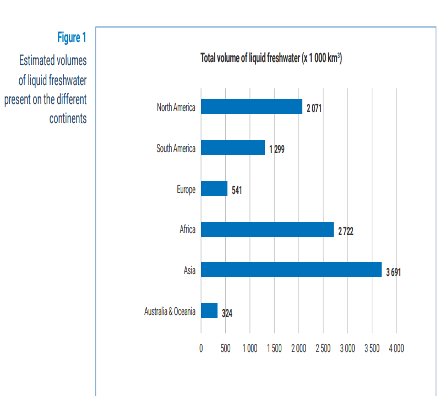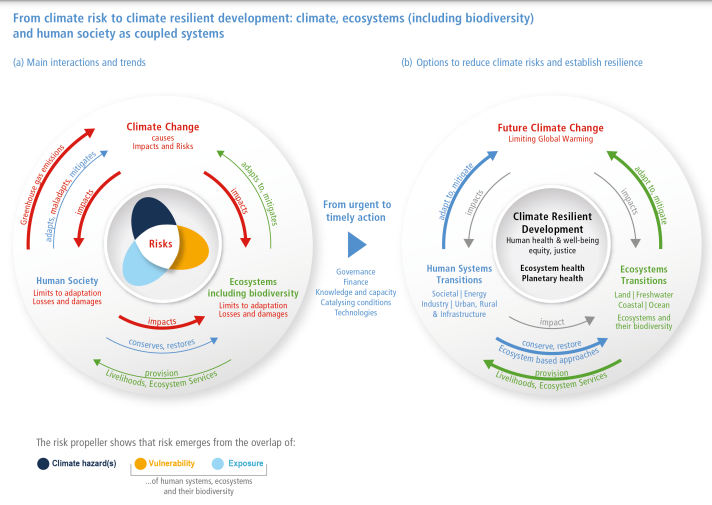09 Apr
Public sector enterprises (PSEs): Their Significance and The Policy of Privatisation
In News
The government is in the process of identifying Central Public Sector Enterprises (CPSEs) in non-strategic sector for divestment or closure. Also, recently the privatisation of Air India was done with its sale to the Tata group.
Introduction
- Public sector enterprises (PSEs), also known as state-owned enterprises (SOEs), have been one of the key drivers of economic development in a number of countries, including India. According to International Finance Corporation (2018), globally, these enterprises account for around 20% of investment, 5% of employment and up to 40% of domestic output.
- In 2019, around 25% of multinational enterprises were owned, controlled, or linked to governments according to the Fortune Global 500 company rankings.
- The developing countries have a higher presence of PSEs among their top companies as compared to the developed countries.
Public Sector Enterprises (PSEs) in India
- In India, post-independence, PSEs have played an important role in development and have been responsible for creating a strong industrial base.
- After independence, the government followed a socialist model with a public-sector led industrial development – the Feldman-Mahalanobis model, which focused on developing a strong capital base through PSEs in core sectors such as railways, steel, power, oil, telecommunications, mining and transportation.
- Indian PSEs have contributed to the development of backward regions, environment protection, promotion of green and energy efficient technologies, capacity building, promotion of social infrastructure such as education and healthcare.
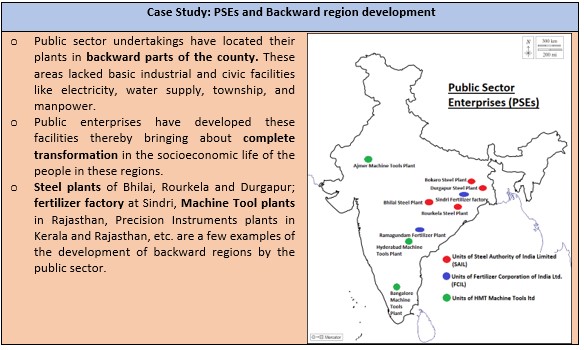
- PSEs have presence in several sectors spanning both goods and services, and many of them are engaged in international trade. They have helped to meet the country’s energy and food security needs and have supported the implementation of government schemes and policies. E.g., Indian Oil Corporation Ltd. (IOCL) supplying gas cylinders for PM Ujjawala Yojana.
- Geopolitical significance: PSEs have started receiving more attention in recent times due to their extensive presence internationally, engaging in cross-border trade and investments and in expanding their geo-strategic reach.
- A majority of the PSEs who have established their presence abroad are present in more than one region. The survey found that while countries in the Middle East were core markets for Indian PSEs in the beginning due to their large reserves of natural resources, these markets are slowly getting saturated. Indian PSEs are now using the Middle East as a hub to expand to new regions such as Africa. At present, majority of them are located in South Asia.

- Exports and Foreign Exchange Earnings: Indian PSEs are engaged in exports of both goods and services. The top goods exported include steel products (such as rails, structural, wire rods, stainless steel sheets, etc.), copper concentrates, aluminium products, petrochemical products and lubricants, polymers, and chemical fertilisers; the top services include consultancy services related to construction, exploration (oil, petroleum, coal, and minerals), mining and railways, and information technology services.

Privatization move
- In the early 1990s, with LPG reforms, India shifted towards a liberalised economy with a larger role for the private sector.
- A number of sectors including telecommunications, power, ports, airports and airlines, which were erstwhile public monopolies, were gradually opened up for privatisation in a phased manner. More recently, private investment has been allowed in strategic sectors like defence.
- With liberalisation, PSEs faced competition from domestic and foreign players. In this environment, some PSEs have grown while others have become loss making units. A number of PSEs have undergone disinvestment and the disinvestment process still continues till date.
- Among various methods of disinvestment followed by the government, a large part of it comes from strategic disinvestment, where there is sale of a substantial portion of the government shareholding of a PSE (up to 50% or higher) including transfer of management control.
Current thrust on Strategic Disinvestment in PSEs
- In Budget Speech for Budget 2021-22, Finance Minister reiterated the government’s commitment to privatise most government-owned firms barring a few in four strategic sectors. The strategic sectors identified include atomic energy, space, and defense; transport and telecommunications; power, petroleum, coal and minerals; and banking, insurance & financial services.
- Government in Budget 2021-22 also announced a four-year (FY 2022-2025) road map for a Rs 6 lakh-crore comprehensive asset monetisation plan by creating a National Monetisation Pipeline, under which assets such as road projects, railway freight corridors, gas and oil pipelines etc would be put up for sale or leased to private players.
- Government had approved New Public Sector Enterprise (PSE) Policy for Atmanirbhar Bharat. The policy provides a clear roadmap for disinvestment in all nonstrategic and strategic sectors.
- The Centre has also released a new set of guidelines for the implementation of this Policy and has entrusted the Department of Public Enterprises (DPE) with the responsibility of identifying PSUs for privatisation or closure in non-strategic sectors.
- According to the new guidelines, privatisation of PSUs in non-strategic sectors will still be undertaken by the Department of Investment and Public Asset Management (DIPAM). But the closure of PSUs in these sectors will be the DPE’s responsibility.

Rationale for Privatization /Strategic Disinvestment
Primary objectives for privatising the PSEs -
- Releasing large amount of public resources and other tangible and intangible resources, such as, large manpower locked up in non-strategic PSEs, for redeployment in areas of higher social priority, such as, basic health, family welfare, primary education, and social and essential infrastructure.
- Government spending that discourages productivity. Some government spending can discourage productivity. For example, welfare benefits can reduce the incentive to work and encourage economic inactivity. Reducing welfare benefits (e.g., making it more difficult to claim sickness/unemployment benefits may encourage people to get a work and become economically active. (Though it may conflict with goals of equity.)
- This also minimises government fiscal deficit and strengthens the fiscal position.
Other benefits expected from privatisation

Challenges Associated with Privatization of PSUs- An Appraisal of Disinvestment Process
- Quality of employment: The CPSEs had 22 Lakh employees in 1989-1990 but by 2019-20 this has already come down to just 10.64 lakhs, a decline of 52%. All actions of the State can be challenged in a Constitutional Court. No such challenge can be brought against a private company jeopardising rights of labour rendered helpless against the immanent possibility of retrenchment.
- Loss of revenue: The justification for the sale of PSUs is that they are a drag on the exchequer and that their sale would stem the bleeding. The fact that many such sale deals (like Air India) are overwhelmingly loaded in favour of debt repayment implies revenue losses for the government.
- Mounting NPAs: Many of the private players who are likely to bid are already heavily indebted to the PSU banks and their failure, which is most likely, will further compound the already precarious NPA crisis for the latter.
- Violation of existing laws & safeguards: Lands were acquired in the past for PSUs under the erstwhile land acquisition law in the name of “public purpose”, a term defined at that time to imply exclusively land acquisition for companies wholly owned by the government. Either allowing such land to be transferred to private companies or monetising them in other ways would violate the land acquisition law.
- Equity: Privatisation in India shows that disinvestment in public enterprises over the years has led to the concentration of economic power, a trend that is disturbingly on the rise taking us towards an oligopoly. The pursuit of privatisation shrinks the space for the State to fulfil its constitutional commitment of empowering the disadvantaged communities.
- Affirmative action: The PSUs are not only expected to provide specifically reserved employment opportunities for the SCs/STs/OBCs but also to empower by ensuring their participation in the decision-making process of the State. Contractualisation, an outcome of deregulations and privatisation, puts the workers outside the scope of the laws governing reservation thereby subverting the affirmative action.
- Private Mismanagement: There is no dearth of contemporary examples of privatised PSU units closed down after mismanagement by their private promoters (e.g., HZL's smelter unit at Visakhapatnam) and private financial institutions mismanaged and taken over into the public sector (e.g. Global Trust Bank).
- Dent to national productive capacities: The intersectoral connections, namely energy, capital goods, machine tools, material/natural resources processing allowed CPSEs is what enabled to them remained effective and competitive, while furthering national self-reliance. Stripping these away would rob them of their effectiveness and ability to contribute to national productive capacities.
- Climate crisis: The agenda of commitments made at the global level by the Indian state in respect of climate change, agriculture transitions (sustainable farming), health transitions and energy transitions require major contributions from the public sector. The continued threat by the privatisation drive, it would be unable to deliver on the future challenges emerging on all these fronts, including technological self-reliance.
Conclusion: Despite these developments, PSEs continue to play an important role in India’s exports and in enhancing the country’s geo-strategic reach. In the Fortune Global 500 list of companies for 2019, India had 7 PSEs, which is the second largest number after China. Prime Minister has emphasised the key role of PSEs in the country’s development and encouraged them to improve competitiveness, innovate and adopt technology, engage more in global trade (especially in exports and outward investments) and enhance value addition in India to make ‘Make in India’ successful. This is needed because unlike China, India has not been able to fully utilise its PSEs to expand its geo-strategic reach and exports. If India wants to engage in new global partnership forums such as the Indo-Pacific and G20, there is need to explore how it can use its PSEs to expand its geo-strategic reach.
Where to use
Geography P1 and P2 – Economic Geography (Industry)
Paper 1 and Paper 3 GS
Sources:
- Govt identifying more PSUs for divestment, closure under new PSE policy
- Is Privatization Good for India?
- Implementation of the new Public Sector Enterprises Policy: How it will redefine the functioning
- Public Sector Enterprises in India: Enhancing Geo-Strategic Reach and Exports
- PRIVATISATION AN AFFRONT TO THE INDIAN CONSTITUTION
- Public Sector Undertakings – Bharat’s Other Ratnas
- Reform and Privatization of State-Owned Enterprises in India
- UNIT 26 PRIVATISATION IN INDIA
- What India can learn from Singapore & China's successful PSU models
- India Best Public Sector Undertaking 2018:
Thinning Antarctica ice shelf collapses after heatwave
In News
An East Antarctica ice shelf (Conger Ice Shelf ) disintegrated recently in March 2022 following a period of extreme heat in the region.
Events of Warming and thinning of ice shelf
- The Antarctic ice sheet is up to 4.8km thick and contains 90% of the world’s fresh water, enough to raise sea level by around 60 metres were it all to melt.
- Since the beginning of satellite observations in the 1970s, the tip of the Conger ice shelf had been disintegrating into icebergs in a series of what glaciologists call calving events.
- Conger was already reduced to a 50km-long and 20km-wide strip attached to Antarctica’s vast continental ice sheet at one end and the ice-covered Bowman Island at the other.
- Two calving events on March 5 and 7 reduced it further, detaching it from Bowman and precipitating its final collapse a week later.
- This is the first time this had happened in East Antarctica since scientists began using satellites to record such events.
Ice Shelves and their Importance
- Ice shelves are sections of glacial ice that extend off land and rest on the ocean, and occasionally “calve,” or break apart, to produce icebergs.
- The world’s largest ice shelves fringe Antarctica, extending its ice sheet into the frigid Southern Ocean. Smaller ice shelves are found where continental ice meets the sea in Greenland, northern Canada, and the Russian Arctic.
- By restraining how much the grounded ice flows upstream, they can control the loss of ice from the interior of the sheet into the ocean.
- When an ice shelf like Conger is lost, the grounded ice once kept behind the shelf may start to flow faster as the restraining force of the ice shelf is lost, resulting in more ice tumbling into the ocean.
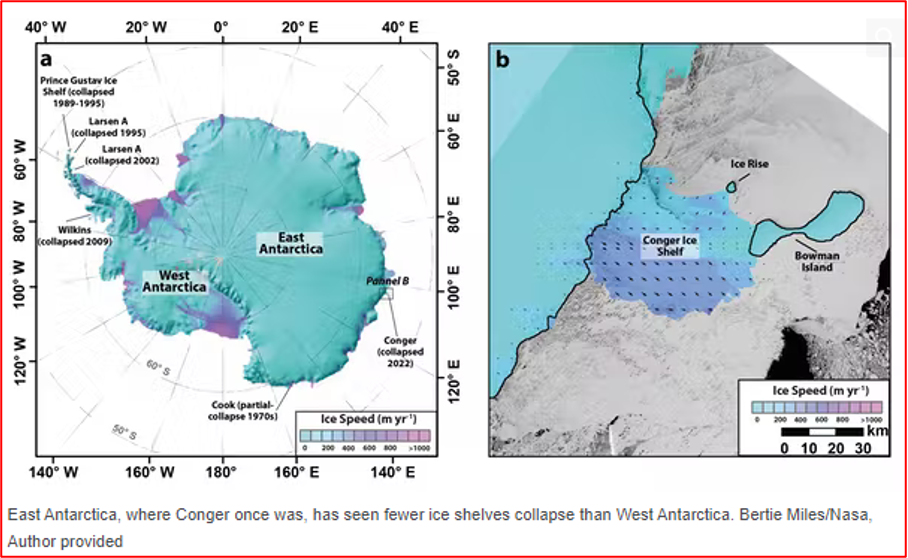
What caused the Collapse?
- The breaking and detachment of parts of ice shelves is a natural process: ice shelves generally go through cycles of slow growth punctuated by isolated calving events. But in recent decades, scientists have seen several large ice shelves undergoing total disintegration.
- Along the Antarctic Peninsula, the whip-like land mass which extends from the West Antarctic mainland, these include Prince Gustav ice shelf (from 1989 to 1995), Larsen A ice shelf (1995), Larsen B (2002), and Wilkins ice shelf (2008 to 2009). In East Antarctica, where Conger once was, cook ice Shelf was partially lost in the 1970s.
- Taken together, this series of collapses suggests that some underlying environmental conditions, such as ocean and atmosphere temperatures, are changing.
- The current collapse came around the same time as a stunning heat wave in the region, which had included temperatures reaching nearly 70 degrees Fahrenheit above normal. The scientific explanation for this latest heatwave in this area lies in atmospheric rivers.
- The warmth and moisture were driven primarily by an atmospheric river – a narrow band of moisture collected from warm oceans. Atmospheric rivers are found on the edge of low-pressure systems and can move large amounts of water across vast distances.
- Eastern Antarctica has always been cold but in this instance an atmospheric river brought warmer and more humid air from Australia to Dome Concordia (Dome C), an Italian - French research station, and it was trapped, causing a micro-greenhouse effect.
- These warm air plumes tend not to extend that far due to a wall of circumpolar winds coming from the west that prevents them from getting in. So, this time it was an exceptional event. Now, the hole in the ozone layer strengthens these winds and, in March, this wall is also reinforced.
- It will have to be investigated, but what is significant is the accumulation of these types of events; at the end of the day there are more heatwaves than cold waves and even if there were no global climate change, their number would remain the same.
- These extreme events are still not well understood, and the climate models could be underestimating them. Researchers forecast that by the end of the 21st century, heatwaves in the eastern Antarctic will increase in duration from nine to 25 days per season, and from nine to 18 days in the western peninsula. Temperatures will also increase, by up to 5ºC, although they are expected to remain below zero in the interior of the Antarctic Plateau.
Effects of Glaciers melting
- Sea level rise and coastal flooding: Resulted in sea rise by 2.7 centimetres since the 60s and glaciers still contain enough to raise the ocean by another half a meter, directly threatening many cities in coastal regions. As a result, coastal erosion has also increased.
- Increased frequency of extreme weather events: sea-level rise leading to storm surges, whereas warm air combining with ocean temperatures lead to increased frequency of coastal storms.
- Loss of ice leads to warmer global temperatures, because of that, hurricanes and other storm are likely to become stronger, floods and droughts will become more common, the world faces the risks of decades’ long mega droughts by 2100.
- Changing Ocean ecosystem at large: Massive amounts of very cold glacial melt water from Antarctica and Greenland entering warmer oceans slows down ocean currents.
- Crumbling Ocean-based industries: Disruption of these currents and jet streams, changed the ocean at large, with changing migrating pattern and fishing grounds collapse of fishing industries is inevitable.
- Loss of species: Many land and sea animals rely on glaciers as their natural habitats and as the glaciers are melting the rich ecological life is becoming more vulnerable. Rising water levels also affects aquatic animals and plants which in turn affects the birds that rely on them.
- Loss of freshwater: Less fresh water will be available since glaciers store about three quarters of the world’s fresh water. The less ice there is, the less water there is for human use, whether it's for drinking, hydroelectric generation, or irrigation.
Conclusion: Global warming is making events like this more likely. And as more and more ice shelves around Antarctica collapse, ice loss will increase, and with it global sea levels. Not everything that happens in nature is due to global warming alone. Antarctica loses mass through the discharge of icebergs and waxing and waning ice shelves as part of a natural cycle. But what we are seeing now, with the collapse of the Conger ice shelf and others, is the continuation of a worrying trend whereby Antarctic ice shelves undergo area-wide collapse one after another.
References
- Antarctic heat, rain and ice prompt concern:
- A heatwave in the coldest place on earth: What does a 40ºC rise in the Antarctic mean?:
- In a First, an Ice Shelf Collapses in East Antarctica
- The Reason Antarctica Is Melting: Shifting Winds, Driven by Global Warming:
- What to Know about Antarctica’s Conger Ice Shelf Collapse:
- Greenland, Antarctica Melting Six Times Faster Than in the 1990s:
- Why is Arctic sea ice decreasing while Antarctic sea ice is not?:
- Glaciers, the great guardians of the stability of the planet's climate:
- Ice shelf collapse: ‘Unknown’ Antarctica still holds surprises
- Alarming heat waves hit Arctic and Antarctica at the same time
- WHY ANTARCTICA SEA ICE RETREATS FASTER THAN IT FORMS:
- Huge ice shelf collapses amid Antarctic heat wave:
Rights- Based Conservation: The path to preserving Earth’s biological diversity
In news
Indigenous land rights have taken center stage at the recent negotiations in Geneva for the U.N. Convention on Biological Diversity.
Poor condition of biodiversity and its conservation around the world
- The Earth is currently undergoing a sixth mass extinction or Anthropocene extinction. The Living Planet Report 2020, published by WWF, has revealed a global species loss of 68 percent in less than 50 years, a catastrophic decline never seen before. Other key findings from the report:
- Converting land for agriculture has caused 70% of global biodiversity loss and half of all loss in tree cover.
- A 94% decline in the Living Planet Index (LPI) for the tropical sub regions of the Americas is the largest fall observed in any part of the world.
- Freshwater species populations have reduced by 84% on average since 1970.
- Since 1970, our Ecological Footprint has exceeded the Earth’s rate of regeneration.
- According to the Global Assessment Report 2019 by IPBES (which works under the auspices of UNEP), around 1 million animal and plant species are now threatened with extinction, many within decades, more than ever before in human history.

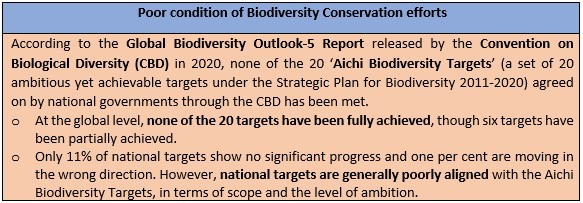
Problem with the conventional fortress model of biodiversity conservation
- Fortress conservation is a conservation model based on the belief that biodiversity protection is best achieved by creating protected areas where ecosystems can function in isolation from human disturbance.
- This includes in-situ efforts such as establishment of National Parks and Wildlife Sanctuaries (terrestrial protected areas), Marine Protected Areas and Biosphere Reserves
- Fortress, or protectionist conservation assumes that local people use natural resources in irrational and destructive ways, and as a result cause biodiversity loss and environmental degradation.
- Creating protected areas involves relocating people or banning access and traditional use of land from its historical inhabitants. An estimated 136 million people have been displaced in the process of formally protecting land.
- It will cause former local resource users to become “conservation refugees” with few livelihood alternatives & they will experience a drastic decline in welfare.
- Strict exclusionary conservation measures may produce meagre conservation gains at the cost of evicting rural communities from their homes and ancestral lands, criminalizing their traditional livelihoods, and violating their human rights to life, health, water, food, an adequate standard of living, non-discrimination and their cultural rights.
- The human rights violations caused by exclusionary conservation disproportionately harm the most vulnerable members of already poor and marginalized groups, especially rural women and children.
What is Rights- Based Approach (RBA) and How does it help in Biodiversity Conservation?
- IUCN defines Rights-based Approaches to conservation (RBA) as “integrating rights norms, standards, and principles into policy, planning, implementation, and outcomes assessment to help ensure that conservation practice respects rights in all cases, and supports their further realization where possible”.
- Indigenous peoples have been the most effective stewards of their lands and of biodiversity since time immemorial. Their sustainable life ways and traditional management systems have proven to be better at protecting the environment than many western conservation approaches.
- Mounting evidence confirms that Indigenous Peoples and other rural rights holders possess the knowledge and ability necessary to successfully conserve and manage biodiverse ecosystems more effectively than governments and at a fraction of the cost, particularly where their rights (including the specific rights of Indigenous and rural women) are recognized, respected and supported.

- Rights Based Conservation is more economical: A study by the Rights and Resources Initiative highlights that globally, 87 billion Indigenous and rural people live within important biodiversity conservation areas spanning 47% of the planet’s terrestrial area, including 363 million people living within existing protected areas.
-
- The same analysis finds that 56% of these 1.87 billion rural people reside in low- and lower-middle income countries—compared with only 9% in high-income countries.
- The conservatively estimated cost of resettling and compensating even one percent “of people in a country’s important biodiversity conservation areas supersedes the cost of recognizing all tenure rights in that jurisdiction.”
Suggestions and Way forward:
- Rights-based approaches are obligatory in all actions to conserve, restore, and share the benefits of Earth’s biodiversity, including conservation financing.
- Legal recognition and protection of land rights: Intergovernmental organizations and institutions should promote the legal recognition and protection of the land and territorial rights of Indigenous Peoples, local communities, and Afro-descendants including their right to self-determination and self-strengthening of their traditional knowledge and governance systems, as the basis for achieving the targets and priorities of the post-2020 global biodiversity framework.
- An ecosystem approach: because people and biodiversity depend on healthily functioning ecosystems that have to be assessed in an integrated way, not constrained by artificial boundaries.
- Apply the precautionary principle: In any situation where important biodiversity may be threatened and there is insufficient knowledge to either quantify risks or implement effective mitigation.
- Take a participatory and welfare approach: Consult widely to ensure that all stakeholders have been consulted and that important biodiversity values are taken into account.
- Environmentalism approach: As there are limits to growth, conservationists must try to incorporate environmentalism approach in improving and protecting the quality of the natural environment through changes to environmental harmful human activities.
Where it can be used?
It can be used in topics related to Paper 1 (Climate change, Biodiversity and sustainable development, Biodiversity conservation) and Paper 2 (Biotic, forest and wildlife resources, Conservation of biodiversity and Environmental management) and GS 3 (Environmental degradation).
Sources:
Pingo
- Pingos are ice-cored hills that form in recently drained lakes. The unfrozen ground directly beneath the lake, called “talik,” is surrounded by permanently frozen ground called permafrost.
- After the lake drains and the water-saturated sediment at the bottom of the lake bed becomes exposed, its surface begins to freeze.
- Without a source of latent heat provided by the lake, the permafrost begins to encapsulate the unfrozen sediments of the lakebed.
- They are found in continuous as well as discontinuous permafrost areas.
- They are abundantly found in the arctic areas (65° N) of Canada, Alaska, Greenland and Siberia.
- They range in height from a few metres to 60 metres (sometimes they are as high as 100 metres) and from a few metres to 300 metres in diameter.
- Small pingos have closed tops whereas big pingos have open tops.

Source:
Urban Ecology
- Urban ecology is the study of the relationships of human and nonhuman organisms in urban areas, the interactions of these organisms with the native and built physical environment, and the effects of these relationships on the fluxes of energy, materials, and information within individual urban systems and between urban and nonurban systems.
- Urban ecology applies the methods and concepts of the biological science of ecology to urban areas, but requires and integrates with the concerns, concepts, and approaches of social sciences to produce a hybrid discipline.
- Urban ecological systems include individual organisms, populations, communities, and landscapes, as well as buildings and infrastructure.
- Urban ecology further recognizes specific urban ecosystems as a part of the global biogeochemical, economic, and human demographic.
- In urban ecology, a key next step is to gain an equally thorough understanding of constructed ecosystems. In short, the entire planet is becoming more urbanized, a phenomenon which is already having a profound effect on the natural systems that maintain breathable air, drinkable water, and fertile soil for agriculture.
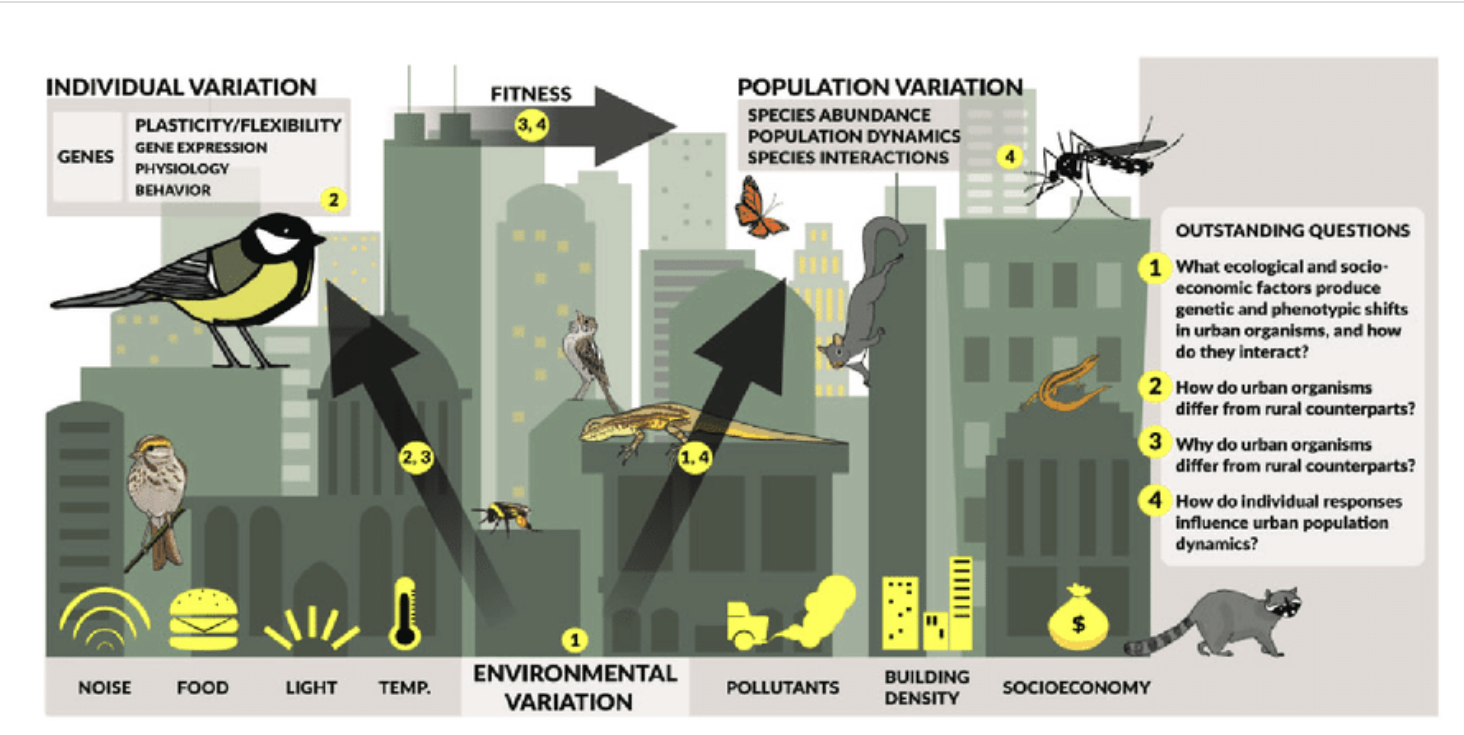
Sources:
THE CHAUKA SYSTEM: AN INNOVATIVE METHOD OF WATER HARVESTING
Problem Statement
- In the late 1970s, Lapodiya, a remote village in Jaipur (Rajasthan), was experiencing its worst drought, leaving its farmers unemployed and starting to affect the social structure of the agrarian community.
- Lapodiya is located in an arid/semi-arid area and at that time, the government used to build mud contours to hold water. But the design was flawed. While this area of Rajasthan is arid or semi-arid, during the monsoon season it can get heavy rains — say, 100 mm all at once — and in many cases the water has broken through the embankment, causing flooding, and washing away topsoil.
- To address the water scarcity in his area, a local village resident and water conservationist, Laxman Singh developed an innovative system, which he called the chauka.
About the Chauka System of Water Harvesting
- A chaukais a rectangular enclosure surrounded on three sides by earthen bunds or embankments (dykes). The dykes are 1.5 metres high. Trees are planted on these dykes to give them additional support to withstand rain.
- In a chaukasystem, series of these rectangles are constructed in a checker-board pattern across a natural slope and connected with shallow canals. The embankments intercept the runoff rainwater and collect it at the “down” end of the bunded field. During heavy rainfall, the water moves gradually from one chauka to another, which gives it more time to seep into the ground.
- The embankments are constructed out of soil dug out of smaller rectangular or square borrow pits within the chauka. As an added benefit, these pits allow the water to infiltrate the soil even more effectively.
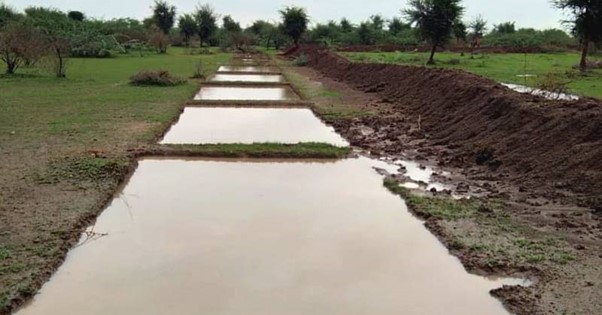
Benefits of the chauka:
- retains runoff water and reduces its velocity across a slope, minimizing erosion
- makes it easy to direct excess water to ponds for storage
- helps to maintain and regenerate natural vegetative cover
- improves water security during droughts
- effective use of marginal areas
Do chaukas work well everywhere?
No. This system is particularly well suited for:
- arid or semi-arid plain areas with erratic or scanty rain patterns
- soil types: sandy loam to loamy (moderate to good infiltration capacity)
- slope of the area not exceeding 0.5-2%
- land is moderately problematic (saline or sodic)
Impact of Chauka System
- Today, Lapodiya’s water problems have ceased to exist. It is probably the only arid village in the state that has abundant water reservoirs, and even when the ponds and wells in the neighbouring villages dry up during the summers, Lapodiya faces no such issue.
- Its success has convinced the state government of Rajasthan, which now encourages communities throughout the state to adopt the chauka Delegations from as far away as Afghanisthan have come to Lapodiya to study water conservation methods.
- The chaukascould be a viable alternative in any pastureland regeneration process in arid and semi-arid regions elsewhere in the world as well, for example in many parts of Australia, Africa or Southwestern United States.
Sources:
Raxaul
|
Raxaul
|
|
Orang National Park
|
|
Bellary
|
|
Rushikulya River
|
|
Sindri
|
|
Mahabubnagar
|

Share the article
Get Latest Updates on Offers, Event dates, and free Mentorship sessions.

Get in touch with our Expert Academic Counsellors 👋
FAQs
Geography Current Affairs focuses on the contemporary issues, events, and developments in the field of geography. It covers recent geographical phenomena, environmental changes, geopolitical shifts, and related news. This differs from regular geography studies which may focus more on foundational concepts, historical contexts, and theoretical frameworks.
Updates are provided regularly to ensure that subscribers stay informed about the latest developments in geography. Typically, updates are provided on a fortnightly basis, depending on the frequency of significant events and changes in the field.
Absolutely. Geography Current Affairs serves as a valuable resource not only for Geography optional but also for GS papers, especially GS Paper 1 (covering Indian Heritage and Culture, History, and Geography of the World and Society) and GS Paper 3 (covering Technology, Economic Development, Biodiversity, Environment, Security, and Disaster Management). It aids in building a holistic understanding of various topics and strengthens answer-writing skills by incorporating contemporary examples and perspectives.
Geography Current Affairs holds immense importance for UPSC preparation, particularly for aspirants opting for Geography optional. It helps candidates stay updated with the latest developments, geographical phenomena, environmental issues, and geopolitical shifts worldwide, aligning them with the dynamic nature of the subject as tested in the UPSC examinations.

